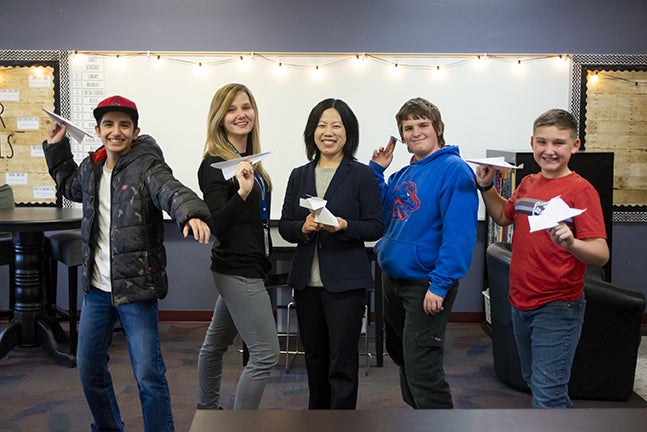
For Dazhi Yang, associate professor in Educational Technology, studying computational thinking isn’t just about research, it’s about community engagement and serving the youngest learners, teaching kids problem solving skills they can use for life.
After securing over $1 million in funding from the National Science Foundation in 2016, Yang and a multidisciplinary team from Boise State including Bhaskar Chittoori, Department of Civil Engineering; Sasha Wang, Department of Mathematics; Steve Swanson, Distinguished Educator in Residence; Dazhi Yang, Yu-hui Ching and Youngkyun Baek, Department of Educational Technology, set about designing a curriculum featuring projects for elementary aged children focused on solving specific challenges using computational thinking strategies. For example, kids are tasked with building a robot to find water in a hypothetical mission to Mars, or to design and build a mock earthquake-resistant bridge to cross the Boise river.
The STEM+C (for computing) curriculum is specifically designed to challenge students to problem-solve in new and creative ways. According to Yang, computational thinking involves strategy in defining problems, challenging students to find patterns and to work together to create and implement solutions – originating from the idea of how a computer is programmed to solve a problem. The idea is for students to continue using this mode of thinking and apply it to any discipline.
The NSF grant allowed Yang and the team to partner with the Boise School District and Boise Parks and Recreation to run the curriculum at after school programs in community centers attached to local elementary schools. Over the past three years, as students worked on the projects, teachers were mentored by the team and shown how to implement the curriculum in their classrooms. The computational thinking projects can then be taught in their classes going forward.
Yang’s research has found that by the time students reach college, learning preferences are more ingrained than when students are younger. Teaching the STEM+C curriculum to elementary students and teachers allows young learners to take the approach with them as they grow. Using the grant to partner with students and more than 20 teachers in Title I schools, where traditionally under-served populations don’t ordinarily have opportunities for hands-on projects led by experts, is an aspect of the research Yang is proud of. “I view my greatest scholarship impact as empowering socially or economically disadvantaged students and providing them an opportunity to advance in life,” Yang said.
Yang’s research is having an impact beyond the Treasure Valley as well. This past December, Ohio State University professor Arnulfo Perez visited Boise State after meeting Yang at a conference in Washington D.C., where Yang spoke about her STEM-C research in Boise schools. After hearing Yang’s talk, Perez became interested in how the curriculum might work in Columbus area schools.
During his visit to Boise, Perez visited the Whitney Elementary community center and gave a research talk on integrating computational thinking in math education. Yang and Perez’ collaboration highlights how university research can be spread to positively impact schools and students in communities around the country.
Yang and the team are now analyzing the data and observations gathered from implementing the curriculum at community centers to show how the curriculum was used and to promote its effectiveness in teaching computational thinking to youngsters.
by Carrie Quinney